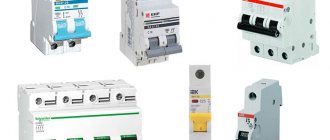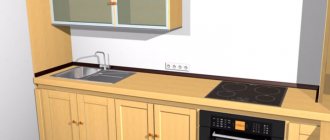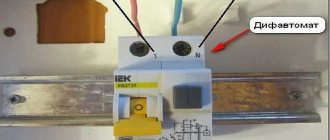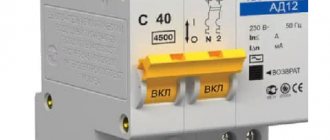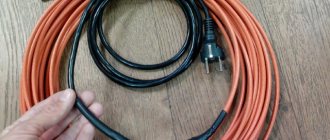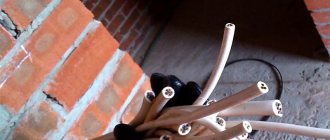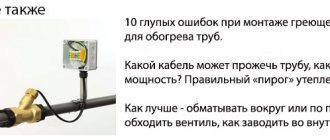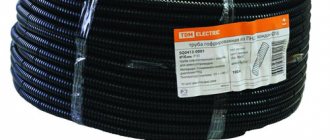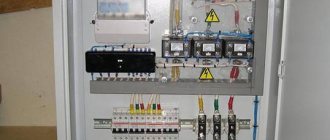For quite some time now, modern homes have stopped using corks. They were replaced by more technological devices - automatic machines, also known as baggers, although some still call them traffic jams, but this is wrong, because the operating principle of a traffic jam and a machine is somewhat different. Since in this article we will consider the selection of a machine depending on the cable cross-section, there will be no talk about traffic jams.
So, the machine is a device that allows you to open the electrical circuit automatically in two cases:
- line current overload;
- occurrence of a short circuit (SC).
In the first case, overload occurs due to a malfunction of electrical appliances or their large number and power density. In the second case, due to a short circuit, electricity is consumed to heat the wires with the maximum possible current for this section. In addition to the above cases of circuit breakage, the machine provides the possibility of manual control. There is a switch on the body of the device that allows you to open the circuit.
The purpose of the circuit breaker is to protect the section of the electrical circuit for which it is installed, as well as timely opening of this section in the event of an overload or short circuit.
Which machine is suitable for 15 kW
The purpose of a 3-phase machine is protection against overcurrents and overloads. The 15 kW modification operates on a network with a voltage of 380 V, that is, you will need a 25 A device for input. When choosing, you need to take into account that in conditions of short circuits, the current strength increases and can cause a fire in the electrical wiring.
When selecting a 15 kW machine model for a three-phase load, you will need to take into account the parameters of the permissible voltage and current during a short circuit. It is worth focusing on the calculated current indicators of the cable with the minimum cross-section that protects the switch and the rated current of the receiver.
When calculating the input switching machine according to power parameters in a 380 V network, the following are taken into account:
- electrical power – actual and additional;
- cable loading intensity;
- availability of free capacity in the design indicator of a residential building;
- remoteness of outbuildings and non-residential premises from the cable entry point.
In a 15 kilowatt network with additional power, an ASU device is installed.
Number of poles
Depending on the number of poles, the machines are:
- Single-pole (1p, 1p). This is the most common type. It stands in a circuit and protects one wire, one phase. This is shown at the beginning of the article.
- Bipolar (2p, 2p). In this case, these are two single-pole circuit breakers, with a combined switch (handle). As soon as the current through one of the machines exceeds the permissible value, both will turn off. These are mainly used to completely disconnect a single-phase load when both the zero and the phase break. It is the two-pole circuit breakers that are used at the entrance to our apartments.
- Three-pole (3p, 3p). Used to break and protect three-phase circuits. Just as in the case of two-pole ones, these are actually three single-pole circuit breakers, with a common on/off handle.
- Four-pole (4p, 4p). They are rare, they are installed mainly at the input of three-phase switchgears (switchgears) to break not only the phases (L1, L2, L3), but also the working zero (N). Attention! Under no circumstances should the protective grounding (PE) wire be broken!
Functions of three-phase machines
Before choosing an automatic switch, you should understand its functionality. Users are often mistaken into thinking that the device protects household appliances. The machine does not respond to its electrical indicators, only triggering in the event of a short circuit or overload. The three-phase functions include:
- simultaneous maintenance of several single-phase circuit zones;
- preventing the formation of overcurrents on the line;
- joint work with AC rectifiers;
- protection of high-power equipment;
- increased power due to the installation of a special converter;
- fast response in short circuit mode on a line with a large number of consumers;
- the ability to turn off manually using a switch or switch;
- Compatible with optional safety terminals.
Without a automatic device, the risk of cable fire increases.
Operating principle and purpose of the circuit breaker
The three-phase circuit breaker is activated in case of a line fault using an electromagnetic switch. The principle of operation of the element is to heat the bimetallic plate at the moment the current rating increases and the voltage is turned off.
The fuse prevents short circuits and overcurrents with values higher than the calculated values from affecting the wiring. Without it, the cable cores heat up to the melting point, which leads to the ignition of the insulating layer. For this reason, it is important to know whether the network can handle the voltage.
Correspondence of wires to load
The problem is typical for old buildings, in which new machines, a meter, and an RCD are installed on the existing line. The machines are selected according to the overall power of the equipment, but sometimes they do not work - the cable smokes or burns.
For example, the cores of an old cable with a cross-section of 1.5 mm2 have a current limit of 19 A. If equipment with a total current of 22.7 A is turned on at a time, only a 25 Ampere modification will provide protection.
The wires will heat up, but the switch will remain turned on until the insulation melts. A fire can be prevented by completely replacing the wiring with a copper cable with a cross-section of 2.5 mm2.
Protecting the weakest section of cable wiring
Based on clause 3.1.4 of the PUE, the task of the automatic device is to prevent overload on the weakest link of the electrical circuit. Its rated current is selected based on the current of the connected household appliances.
If the machine is selected incorrectly, the unprotected area will cause a fire.
Wiring
Ideally, if the machines are located next to each other on a DIN rail, then these distances can be measured simply by attaching a conductor so that the transition part from one machine to another forms a loop. This will allow the wire to exit the housing vertically.
The stripped area should be twice as long as the end of the wire, because we will have to make a small loop out of it, which will be used to connect the machine. You will need to put heat-shrink tubing on this loop or tightly wrap it with electrical tape at the place where the insulation ends. This will give our wire rigidity.
Then the loop must be inserted into the contact hole of the machine and tightened tightly. The cleaned areas should correspond to the number of circuit breakers. But we will be sure that the phase is separated correctly - the same for the apartment.
Principles for calculating the machine according to the cable cross-section
Calculations for a 3-phase automatic circuit breaker are carried out based on the cable cross-section. For a 25 A model, you will need to refer to the table.
| Wire cross-section, mm2 | Permissible load current based on cable material | |
| Copper | Aluminum | |
| 0,75 | 11 | 8 |
| 1 | 15 | 11 |
| 1,5 | 17 | 13 |
| 2,5 | 25 | 19 |
| 4 | 35 | 28 |
The 25 Ampere modification can be used to protect wiring or installed at the input.
For example, a copper wire with a cross-section of 1.5 mm2 with a permissible load current of 19 A is used for wiring. To prevent the cable from heating up, you will need to select a lower value - 16 A.
Selection of automatic switch by power
Calculating the total power of household appliances will help you select a protective switch. You will need to look at the value in the device passport. For example, in the kitchen the following are plugged into the socket:
- coffee maker – 1000 W;
- electric oven – 2000 W;
- microwave oven – 2000 W;
- electric kettle – 1000 W;
- refrigerator – 500 W.
Summing up the indicators, we get 6500 W or 6.5 kilowatts. Next, you will need to refer to the table of machines depending on the connection power.
| Single-phase connection 220 V | Three-phase connection | Machine power | |
| Delta circuit 380 V | Star circuit, 220 V | ||
| 3.5 kW | 18.2 kW | 10.6 kW | 16 A |
| 4.4 kW | 22.8 kW | 13.2 kW | 20 A |
| 5.5 kW | 28.5 kW | 16.5 kW | 25 A |
| 7 kW | 36.5 kW | 21.1 kW | 32 A |
| 8.8 kW | 45.6 kW | 26.4 kW | 40 A |
Based on the standard voltage wiring table, you can select a 32 A device that is suitable for a total power of 7 kW.
If you plan to connect additional equipment, an increase factor is used. The average value of 1.5 is multiplied by the power obtained from the calculations. A reduction factor is applied if it is impossible to operate several electrical appliances at the same time. It is equal to 1 or minus 1.
Selecting a machine depending on the load power
For apartments and houses with new electrical wiring, the choice of machine is made based on the calculated load current.
A three-phase type device can be calculated by the rated load current or by the response speed in conditions of exceeding the current value. For calculations, you need to add up the power of all consumers and calculate the current passing through the line. Work is performed according to the formula:
- P – total power of all household appliances;
- U – network voltage.
For example, the power is 7.2 kW, calculated using the formula 7200/220 = 32.72 A. The table shows ratings of 16, 20, 32, 25 and 40 A. The value is 32.72 A, taking into account the operation of the device at a value of 1 ,13 times more than the nominal value, multiply: 32x1.13=36.1 A. The table shows that it is better to install a 40 A model.
What is tension? Volt [V]
Voltage is a physical quantity that characterizes the ratio of the work of the electric field in the process of transferring a charge from one point A to another point B to the value of this same charge. Simply put, it is the potential difference between two points. Measured in Volts.
The voltage is essentially similar to the amount of water pressure in the pipe; the higher it is, the faster the water flows from the tap. The voltage is standardized and the same for all apartments, houses and garages, equal to 220 Volts with single-phase power supply. Also allowed according to GOST is a 10 percent deviation for the home electrical network. The voltage must be no less than 198 and no more than 242 Volts.
1 Volt contains:
- 1,000,000 microvolts
- 1,000 millivolts
Methods for selecting a difavtomat
For example, consider a kitchen where a large amount of equipment is connected. First, you need to set the total power rating for a room with a refrigerator (500 W), microwave (1000 W), kettle (1500 W) and hood (100 W). The total power indicator is 3.1 kW. Based on it, various methods are used to select a 3-phase machine.
Table method
Based on the device table, a single-phase or three-phase device is selected based on the connection power. But the value in the calculations may not coincide with the tabular data. For a 3.1 kW network section, you will need a 16 A model - the closest value is 3.5 kW.
Graphical method
The selection technology is no different from the tabular one - you will need to find a schedule on the Internet. In the figure, the switches with their current load are shown horizontally, and the power consumption in one section of the circuit is shown vertically.
To establish the power of the device, you will need to draw a line horizontally to the point with the rated current. A total network load of 3.1 kW corresponds to a 16 A switch.
Nuances to consider
No one can know exactly what household appliances will be in a house or apartment. For this reason you should:
- increase the total calculated power of a three-phase automatic circuit breaker by 50%, or apply an increase factor of 1.5;
- a reduction factor is taken into account when there are not enough sockets in the room to simultaneously connect equipment;
- to simplify calculations, the load should be divided into groups;
- powerful devices should be connected separately, taking into account the low-power load;
- to calculate a low-power load, you will need to divide the power by the voltage;
- wiring is the main factor that is taken into account when choosing a 3-phase automatic switch; old aluminum wires can withstand 10 A, but if taken for 16 A sockets, they can melt;
- in domestic conditions, models with current ratings of 6, 16, 25, 32 and 40 A are most often used.
When purchasing a three-phase differential circuit breaker, you need to take into account that the main markings are on the case or in the passport. Using formulas and tables will help you choose a model in accordance with the wiring in the apartment and the power of household appliances.
Long gone are the days of ceramic plugs that were screwed into home electrical panels. Currently, various types of circuit breakers that perform protective functions are widely used. These devices are very effective against short circuits and overloads. Many consumers have not yet fully mastered these devices, so the question often arises which machine should be installed at 15 kW. The reliable and durable operation of electrical networks, appliances and equipment in a house or apartment completely depends on the choice of machine.
Some useful tips for assembling a shield
When assembling an electrical panel, it is necessary to use only high-quality and reliable electrical products. You should not pay attention to cheaper Chinese analogues; personal safety is much more important.
To connect wires to machines, it is best to use special lugs for crimping. Of course, then you will have to purchase pliers with which crimping is performed, but their cost is not too high.
The use of insulating tape is no longer relevant; many electricians use exclusively heat-shrinkable tubing. This consumable is convenient and reliable, and it is not necessary to purchase a hair dryer; you can use an ordinary lighter.
For ease of use, all elements of the electrical cabinet must be marked. Only then will it be possible to quickly and easily turn off the voltage in a certain room. You can make notes on the body of the device or make small signs and attach them to the product with tape.
Basic functions of machines
Before choosing an automatic protective device, you need to understand the principles of its operation and capabilities. Many people consider the main function of the machine to be the protection of household appliances. However, this judgment is absolutely wrong. The machine does not react in any way to devices connected to the network; it is triggered only during short circuits or overloads. These critical conditions lead to a sharp increase in current strength, causing overheating and even fire of cables.
A special increase in current strength is observed during a short circuit. At this moment, its value increases to several thousand amperes and the cables are simply not able to withstand such a load, especially if its cross-section is 2.5 mm2. With such a cross-section, an instant fire occurs in the wire.
Therefore, a lot depends on the correct choice of machine. Accurate calculations, including power calculations, make it possible to reliably protect the electrical network.
Lower level of sockets
The lower level of outlets is planned for most built-in kitchen appliances.
- Microwave;
- Oven;
- Hob;
- Dishwasher;
- Waste shredder (Disposer);
- Washing machine;
- Fridge.
The unspoken rules for installing kitchen outlets state that the height of the bottom row of outlets from the floor is 10 cm. This is the standard level of the bottom outlets behind the kitchen. At this height, the lower sockets fall into the free space between the floor and the beginning of the floor cabinets. 10 cm should not be to the middle, but to the top of the sockets, since the height of the legs of kitchen cabinets is usually 12.5 cm. True, the height of the legs is adjustable, but not by much. In kitchen cabinets without legs, a special cutout is made at the back at the factory, usually at a height of 11.4 cm from the floor (it is clearly visible in the photo).
Related article: Electrical wiring in the kitchen: location of sockets in the kitchen
Machine calculation parameters
Each circuit breaker primarily protects the wiring connected downstream of it. Basic calculations of these devices are carried out based on the rated load current. Power calculations are carried out in the case when the entire length of the wire is designed to carry the load, in accordance with the rated current.
The final choice of rated current for the machine depends on the cross-section of the wire. Only after this can the load value be calculated. The maximum current allowed for a wire with a certain cross-section must be greater than the rated current indicated on the machine. Thus, when choosing a protective device, the minimum wire cross-section present in the electrical network is used.
When consumers have a question about which machine should be installed at 15 kW, the table also takes into account the three-phase electrical network. There is a methodology for such calculations. In these cases, the rated power of a three-phase circuit breaker is determined as the sum of the powers of all electrical appliances planned to be connected through the circuit breaker.
Industrial or homemade shield?
Nowadays different shields are sold. All kinds of shapes and sizes. They have either a primed metal, painted base or a plastic base. There are also brushes with internal factory filling. There are designs available for individual order.
But, if the shield installer has certain skills, then it is better to install the internal parts yourself, at your own discretion. The more experience, the more competently the installation of the structure in a certain volume of the electrical panel will be completed.
Basic functions of machines
Before choosing an automatic protective device, you need to understand the principles of its operation and capabilities. Many people consider the main function of the machine to be the protection of household appliances. However, this judgment is absolutely wrong. The machine does not react in any way to devices connected to the network; it is triggered only during short circuits or overloads. These critical conditions lead to a sharp increase in current strength, causing overheating and even fire of cables.
A special increase in current strength is observed during a short circuit. At this moment, its value increases to several thousand amperes and the cables are simply not able to withstand such a load, especially if its cross-section is 2.5 mm2. With such a cross-section, an instant fire occurs in the wire.
Therefore, a lot depends on the correct choice of machine. Accurate calculations, including power calculations, make it possible to reliably protect the electrical network.
Average level of sockets
The middle level of sockets is designed for temporary connection of portable household appliances. This level of outlets is called additional outlet blocks. You can plan any number of such sockets. In this example, two blocks of three sockets are planned above the desktop tabletop.
The height of the middle level sockets is taken to be 10-15 cm above the level of the working surface of the table, which corresponds to 110-115 cm from the floor level for low kitchens or 115-120 cm for kitchen cabinets with a high base.
Machine calculation parameters
Each circuit breaker primarily protects the wiring connected downstream of it. Basic calculations of these devices are carried out based on the rated load current. Power calculations are carried out in the case when the entire length of the wire is designed to carry the load, in accordance with the rated current.
The final choice of rated current for the machine depends on the cross-section of the wire. Only after this can the load value be calculated. The maximum current allowed for a wire with a certain cross-section must be greater than the rated current indicated on the machine. Thus, when choosing a protective device, the minimum wire cross-section present in the electrical network is used.
When consumers have a question about which machine should be installed at 15 kW, the table also takes into account the three-phase electrical network. There is a methodology for such calculations. In these cases, the rated power of a three-phase circuit breaker is determined as the sum of the powers of all electrical appliances planned to be connected through the circuit breaker.
For example, if the load of each of the three phases is 5 kW, then the operating current is determined by multiplying the sum of the powers of all phases by a factor of 1.52. Thus, it turns out 5x3x1.52 = 22.8 amperes. The rated current of the machine must exceed the operating current. In this regard, the most suitable protective device would be rated 25 A. The most common ratings of circuit breakers are 6, 10, 16, 20, 25, 32, 40, 50, 63, 80 and 100 amperes. At the same time, the compliance of the cable cores with the declared loads is clarified.
This technique can be used only in cases where the load is the same on all three phases. If one of the phases consumes more power than all the others, then the rating of the circuit breaker is calculated based on the power of this particular phase. In this case, only the maximum power value is used, multiplied by a factor of 4.55. These calculations allow you to select a machine not only according to the table, but also according to the most accurate data obtained.
Step-by-step instructions on how to connect a single-core wire
After you have purchased the RCD and all the necessary devices for installation, you can begin to work. It must be remembered that all stages of installation must be carried out sequentially and all safety measures must be taken.
Practical advice
Experienced electricians recommend installation in the following sequence:
- de-energize the shield. Check the presence of current using the indicator;
- care must be taken to ensure that no one unexpectedly turns on the electricity;
- the equipment must be firmly snapped onto the DIN rail;
- Electricians recommend connecting the device according to this principle - all incoming wires are at the top, and outgoing wires are at the bottom. This generally accepted scheme will help avoid confusion when replacing equipment;
- there should be no kinks in the wiring when connecting;
- disconnect excess parts of the cable with wire cutters;
- Carefully remove the insulation from the cable by 10 mm;
- Install the cable into the required terminals and secure it. It is necessary to monitor the clamping force - tightly twisted terminals will quickly lead to breakage of the switch;
- turn on the power supply;
- check the voltage access to the switch using an indicator.
Common Mistakes
Sometimes it happens that the power switch does not perform its functions, so you have to reinstall it again. To avoid malfunctions, you need to avoid the following installation errors:
- the insulation from the wire has come into contact. If the insulation is not removed before installation, this increases the risk of a short circuit that leads to a fire;
- connecting several wires with different cross-sections to one terminal. In this case, only a large cross-section core is tightened well, and thin wires have poor contact, which leads to melting of the housing and a fire. This happens when connecting various devices to the switch. To avoid this, you need to use jumpers between cables and devices. They are made from wires of the same cross-section;
- Do not connect copper and aluminum wires together. The device will become unusable due to the oxidation process when two metals are combined;
- You should not connect a straight wire to the terminal, but you need to bend it with a hook, which will increase the contact area and increase the performance of the device; such a cable is also more difficult to pull out of the device.
